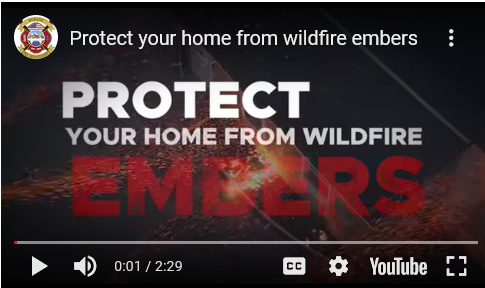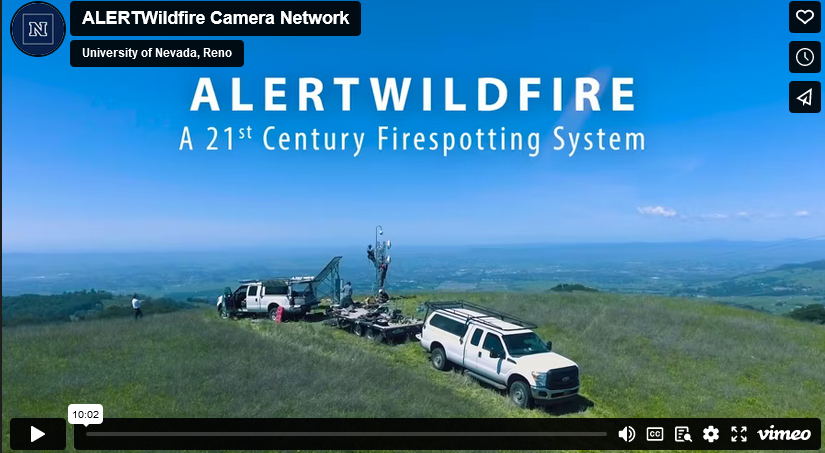By Representative David Gomberg, House District 10
9/11/2023
Hello Neighbors and Friends,
September 11 is a solemn date in American history. I’m sure all of you remember where you were and what you were doing when the almost unbelievable news unfolded.
Saturday evening, Susan and I stopped by a community gathering in Otis. People danced to music, chatted with neighbors, and ate together. No one called it an “anniversary”. But everyone understood that the Echo Mountain Complex fires devastated these communities exactly three years ago.
Earlier in the day, I visited a first responder appreciation event in Monroe. I told the firefighters there our own story. How the power had been off for three days when we received the evacuation notice at six in the morning. How we had a plan and applied it. How we scrambled to collect our precious possessions and pets with the only light a red glow coming over the hillside. How we looked around one last time at the house that had been our home over the course of 30 years and then left, not knowing if it would be there when we returned.
We were evacuated for ten days. When we returned, much of our property had burned but the house was untouched. “A miracle,” Susie said. “A miracle wearing a yellow shirt and a hard hat,” I replied. Firefighters had fought to save many homes on our street but a third were still lost. Throughout Otis, 300 homes burned. The community responded, opening their spare bedrooms, wallets, and hearts to the survivors. Many still struggle and half the homes lost on my street have not yet been rebuilt. Some won’t be coming back. The post-fire trauma persists.
My point in sharing this personal perspective is to remind you the fire danger is real and can affect any of us.

A Newport Fire Department rig able to drive on the beach sprays water on a 300-yard-long fire burning between Waldport and Yachats. Yachats News photo.
Earlier this summer, families were evacuated near Waldport when fireworks ignited dry vegetation along the dunes. According to the Oregon Department of Emergency Management, more than 70% of wildfires are human-caused. Here are some ways you can do your part to prevent that from happening:
Keep Oregon Green: Keep Oregon Green has prevention tips for when Oregonians are out and about, at work or at home. Visit this link for fire safety and prevention tips.
Campfires and Burn Pits: Depending on where you are in Oregon and that area’s fire environment, restrictions or bans may be in effect limiting certain activities that commonly start wildfires. Check out this link and the Oregon State Fire Marshal’s webpage for more information on public fire restrictions and education materials.
Restrictions and Closures: The Oregon Department of Forestry and their partners implement restrictions on public and work related activities. Find out about restrictions and closures by visiting their webpage.
Defensible Spaces for Your Home: Creating a defensible space between your home and the wildland area around it can give your home an increased chance of surviving a wildfire. Learn more about how defensible space works at this link.
This short but useful video shows some steps you can take in a weekend to protect your home.
Make a Plan: Make sure you and your family are prepared in case of an emergency. Visit this link to learn more about developing an emergency plan and creating a go-kit ready with supplies for health, safety and identification.
Sign Up for Emergency Alerts: Get lifesaving alerts and instructions during emergencies by signing up for alerts here.
Track Fires and Air Quality: Visit the Oregon Department of Forestry’s site to track fires and air quality throughout the state. If there’s smoke in the air, you can protect your home by following these tips. Read more about what to do when there’s smoke in the air.
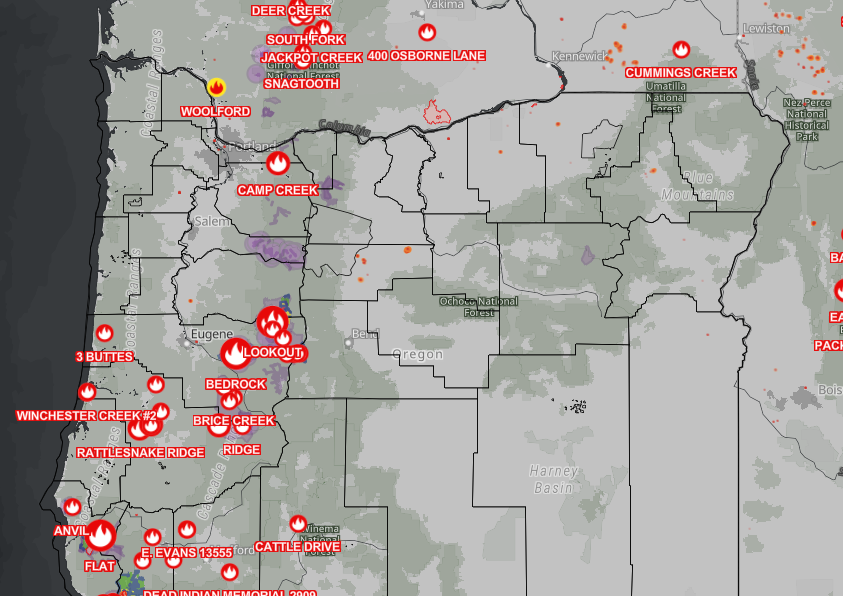
Thirty-three active fires in Oregon this weekend.
Understanding Evacuation Levels: According to the Oregon Department of Emergency Management, Oregon follows a 3 Level evacuation notification system, each structured around the readiness need and threat level. To learn about these levels, what they mean and make the best decision to stay safe, visit this website.
Cross off the Checklist: Be prepared to evacuate by reviewing a prepared checklist that will help you feel supported and ready. Here is an evacuation checklist for homes.
During the last session, I supported efforts to improve our statewide emergency management systems to better respond to natural disasters and fire, passed legislation to encourage better disaster education in our schools, and strengthened support for Oregonians affected by disasters.
I was pleased to co-sponsor House Bill 2522, which directs the State Fire Marshal to conduct a full overview of our rural fire protection-related laws to modernize and streamline our processes and programs. I also introduced and passed House Bill 2902, which directs the Department of Education to develop guidance materials for schools to better prepare their students for natural disasters.
I sponsored House Bill 2812 to allow tax deductions for fire losses. I sponsored but was unable to pass Senate Bill 1012 to reduce property taxes on homes rebuilt after a fire.
SB 80 will put a lot more coherence, transparency and public involvement in the wildfire mapping process, and SB 82 should improve transparency and cooperation between insurance companies and policyholders who live in hazardous areas.
Two years ago, Oregon lawmakers put $220 million toward overhauling wildfire prevention policies. Senate Bill 762 is comprehensive legislation passed with bipartisan support to help Oregon modernize and improve wildfire preparedness through three key strategies: creating fire-adapted communities, developing safe and effective responses, and increasing the resiliency of Oregon’s landscapes.
We’re doing a better job of identifying, responding, containing, and recovering. But that is no excuse for complacency. We’ve learned here in my own neighborhood that the fire danger is real – even on the cool rainy coast.
Virtual fire towers now help us spot wildfires sooner.
|
|
I mentioned earlier that we were in Monroe again on Saturday.
I had come to speak to first responders there. But before we left, Mayor Sheets surprised me with some very kind remarks thanking our office for working to secure funds to replace the city’s failing water infrastructure.
I often talk about the challenge that small towns face with big, expensive, and necessary infrastructure projects. How does Monroe come up with a million dollars, or Waldport with eight million, or Newport with 90 million?? They do it with help from lottery bonds, state grants, or federal funds. And it is my job to help them get it.
When Benton and Lane Counties were added to our large “coastal” district in January, I worried they would feel forgotten. They were not. We secured $1.3 million for Monroe and $1.9 million for Philomath. Together, over the past five years, we have brought more than $100 million back to critical investments across our district. More needs to be done. But I’m confident those dollars are making a difference.
Over the weekend we visited Philomath, Monroe, and Corvallis to talk about Community Services, a remarkable robotics lab, and first responders.
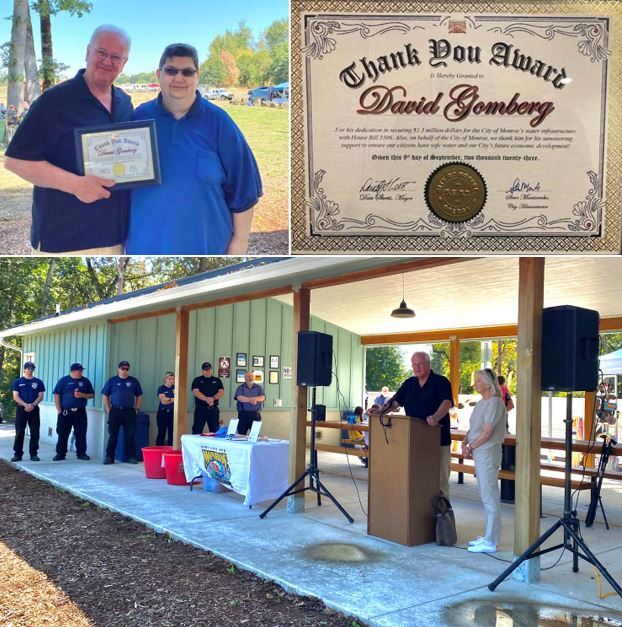
At the City of Monroe’s Annual First Responder’s event.
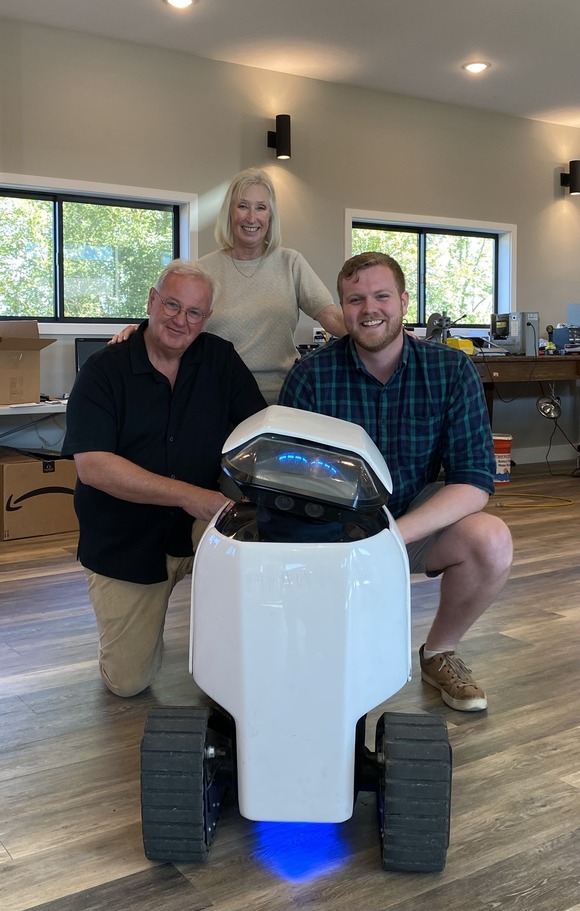 |
Posing with Daxbot! That’s Christopher McMorran, Philomath City Councilor
|
|
 Susan and I were in Yachats last week and took some time to hike to a small clearing in the forest south of town and visit the Amanda Statue.
Susan and I were in Yachats last week and took some time to hike to a small clearing in the forest south of town and visit the Amanda Statue.
Joanne Kittel, a leader in the Yachats trails movement and advocate for Native American truths will be honored this week by the National Association of State Park Directors with its highest individual honor — the President’s Award.
The statue is surrounded by green forest, resting in a sheltered space below the cliffs of Cape Perpetua at the edge of the Pacific Ocean. At the foot of the small stone monument are gifts: feathers, stones, necklaces, shells and flowers.
The statue and trail are dedicated in memory of Amanda, a woman of the Coos Tribe who was forcibly marched to the Alsea Sub-agency camp in the 1860s. For many, the Indigenous woman’s story is almost unbearably sad, about the horrors we can inflict on each other, a deep wound in this beautiful place.
Amanda’s trail and clearing represent a remarkable effort to recognize our Indigenous history. It resulted from the combined efforts of a small group of Yachats residents, the Coos, Lower Umpqua & Siuslaw, and Confederated Tribes of Siletz Indians, joined with the U.S. Forest Service and the Oregon Parks and Recreation Department, which manage most public lands on the central coast. Together, they have created and maintained a network of trails that offer an unflinching look at local Indigenous history.
You can hike the six-mile trail or park and take a short walk to the Amanda Clearing. Susan and I lingered for a while in this thoughtful place and before I left, I placed a small visitation stone with the statue.
|
|
Last week I met with OPAC, the Oregon Ocean Policy Advisory Council. And next Tuesday I meet with OSSPAC, the Oregon Seismic Safety Policy Advisory Commission.
See how it gets confusing??
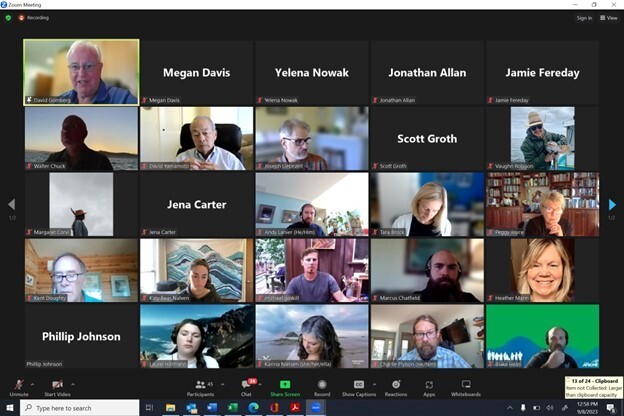
I met with OPAC to review state support and finding of the Marine Reserves program.
As the Beaver Creek spraying situation evolves, I will talk with a coalition of environmental organizations Monday. I met with farming and forestry groups last week. I have, of course, been in touch with local residents. The property owner at the center of the spraying still declines to meet with me.
Tuesday I will also be the guest of Yaquina Broadcasting on their Hotline program. Later in the day I’ll be at the formal dedication of the Gladys Valley Marine Science Building at the Hatfield Center.
Wednesday I address Oregon Housing Authority Directors and then scoot for Waldport and their Chamber Social.
Thursday is a meeting of the Governor’s Commission on Senior Services and I’ll lunch with the Director of the Small Business Development Center (SBDC) network.
Friday I’m pleased to be the guest auctioneer at the Newport Symphony Gala. And Saturday, I leave on a six-day legislative trade mission to Taiwan where we will work to improve exchanges with Oregon’s largest overseas trade partner. More about that later!
I have meetings during the week to help prioritize policy proposals for the January legislative session, and to craft a proposal intended to end legislative walkouts.
So the week ahead is, as usual, a busy one. As I traverse our huge district, I take time to appreciate the remarkable scenery and wonderful fall weather. I hope you do the same.
|
|
email: Rep.DavidGomberg@oregonlegislature.gov
phone: 503-986-1410
address: 900 Court St NE, H-480, Salem, OR, 97301
website: http://www.oregonlegislature.gov/gomberg



